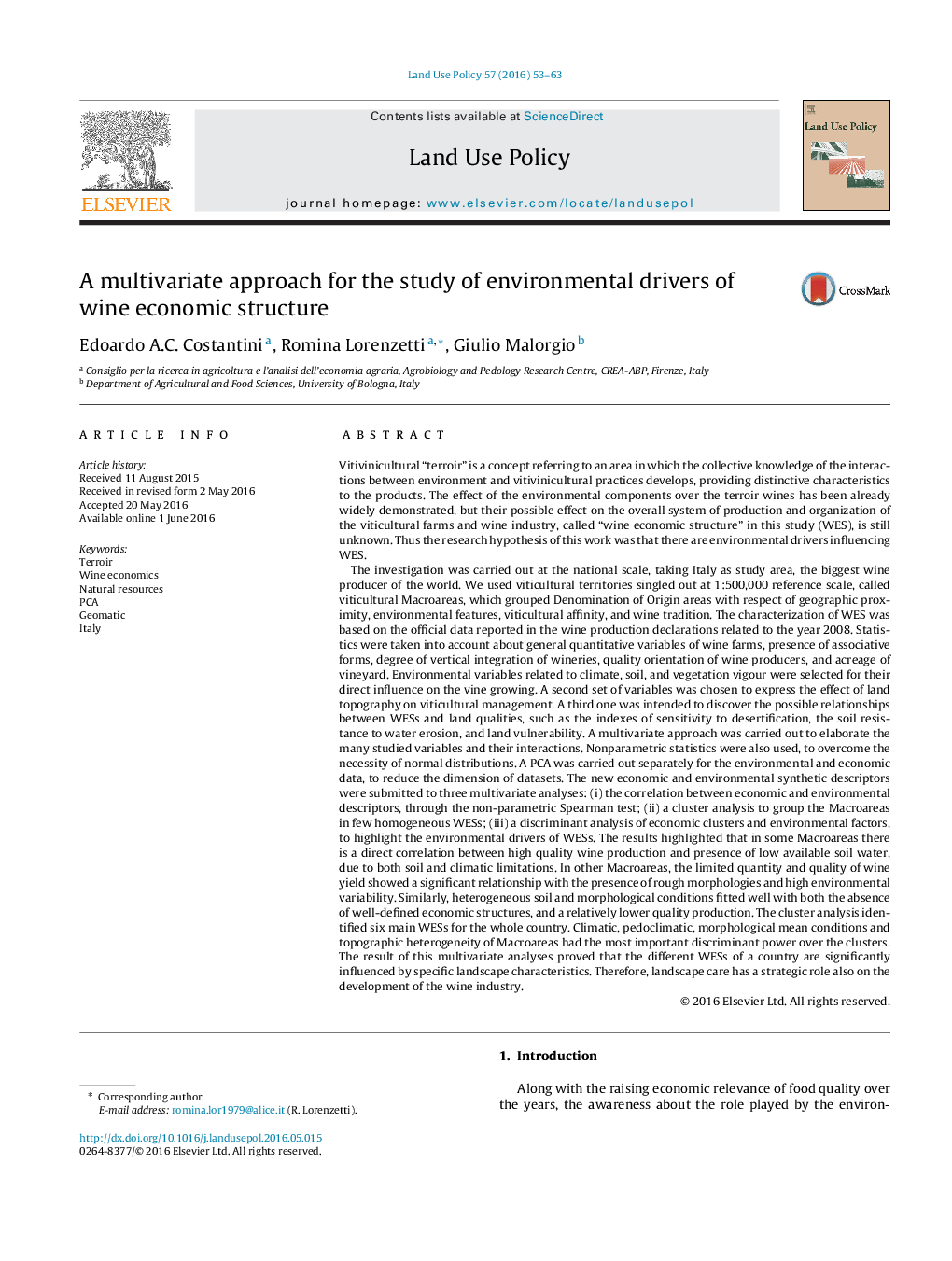| کد مقاله | کد نشریه | سال انتشار | مقاله انگلیسی | نسخه تمام متن |
|---|---|---|---|---|
| 6546971 | 160091 | 2016 | 11 صفحه PDF | دانلود رایگان |
عنوان انگلیسی مقاله ISI
A multivariate approach for the study of environmental drivers of wine economic structure
ترجمه فارسی عنوان
یک رویکرد چند متغیره برای مطالعه رانندگان زیست محیطی ساختار اقتصادی شراب
دانلود مقاله + سفارش ترجمه
دانلود مقاله ISI انگلیسی
رایگان برای ایرانیان
موضوعات مرتبط
علوم زیستی و بیوفناوری
علوم کشاورزی و بیولوژیک
جنگلداری
چکیده انگلیسی
The investigation was carried out at the national scale, taking Italy as study area, the biggest wine producer of the world. We used viticultural territories singled out at 1:500,000 reference scale, called viticultural Macroareas, which grouped Denomination of Origin areas with respect of geographic proximity, environmental features, viticultural affinity, and wine tradition. The characterization of WES was based on the official data reported in the wine production declarations related to the year 2008. Statistics were taken into account about general quantitative variables of wine farms, presence of associative forms, degree of vertical integration of wineries, quality orientation of wine producers, and acreage of vineyard. Environmental variables related to climate, soil, and vegetation vigour were selected for their direct influence on the vine growing. A second set of variables was chosen to express the effect of land topography on viticultural management. A third one was intended to discover the possible relationships between WESs and land qualities, such as the indexes of sensitivity to desertification, the soil resistance to water erosion, and land vulnerability. A multivariate approach was carried out to elaborate the many studied variables and their interactions. Nonparametric statistics were also used, to overcome the necessity of normal distributions. A PCA was carried out separately for the environmental and economic data, to reduce the dimension of datasets. The new economic and environmental synthetic descriptors were submitted to three multivariate analyses: (i) the correlation between economic and environmental descriptors, through the non-parametric Spearman test; (ii) a cluster analysis to group the Macroareas in few homogeneous WESs; (iii) a discriminant analysis of economic clusters and environmental factors, to highlight the environmental drivers of WESs. The results highlighted that in some Macroareas there is a direct correlation between high quality wine production and presence of low available soil water, due to both soil and climatic limitations. In other Macroareas, the limited quantity and quality of wine yield showed a significant relationship with the presence of rough morphologies and high environmental variability. Similarly, heterogeneous soil and morphological conditions fitted well with both the absence of well-defined economic structures, and a relatively lower quality production. The cluster analysis identified six main WESs for the whole country. Climatic, pedoclimatic, morphological mean conditions and topographic heterogeneity of Macroareas had the most important discriminant power over the clusters. The result of this multivariate analyses proved that the different WESs of a country are significantly influenced by specific landscape characteristics. Therefore, landscape care has a strategic role also on the development of the wine industry.
ناشر
Database: Elsevier - ScienceDirect (ساینس دایرکت)
Journal: Land Use Policy - Volume 57, 30 November 2016, Pages 53-63
Journal: Land Use Policy - Volume 57, 30 November 2016, Pages 53-63
نویسندگان
Edoardo A.C. Costantini, Romina Lorenzetti, Giulio Malorgio,
